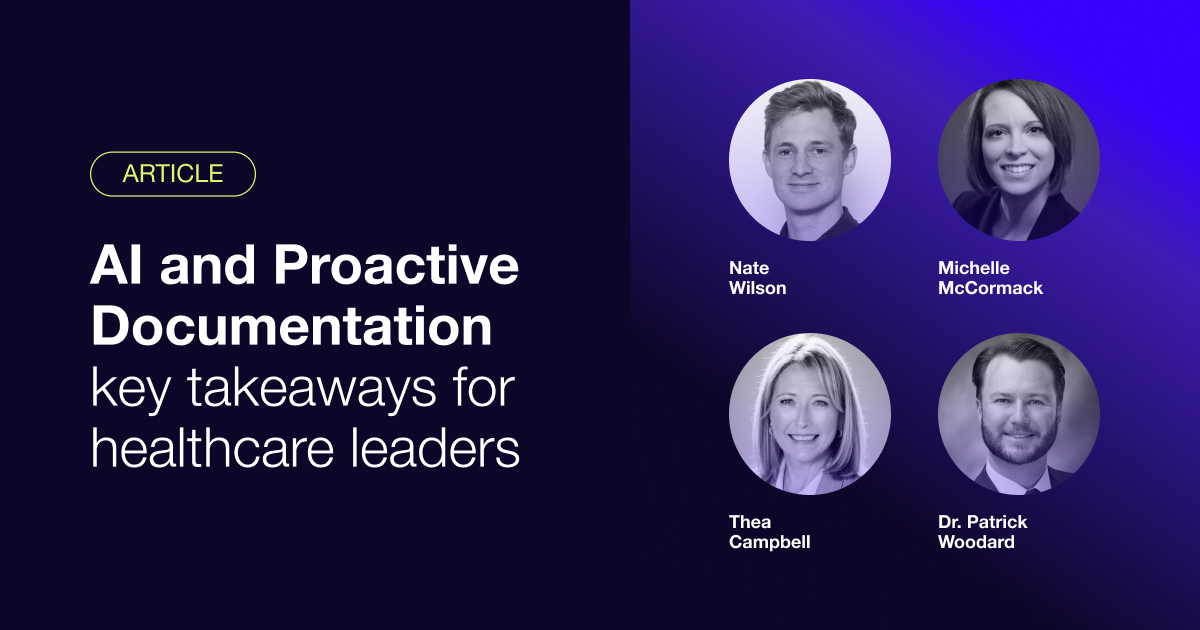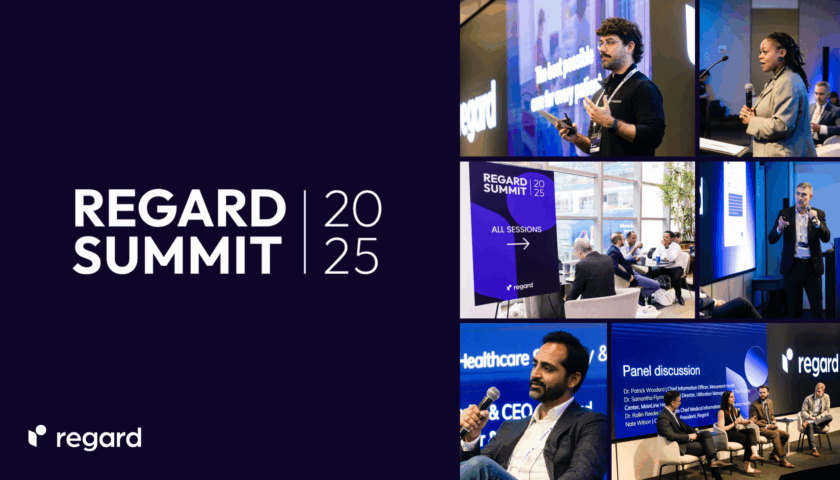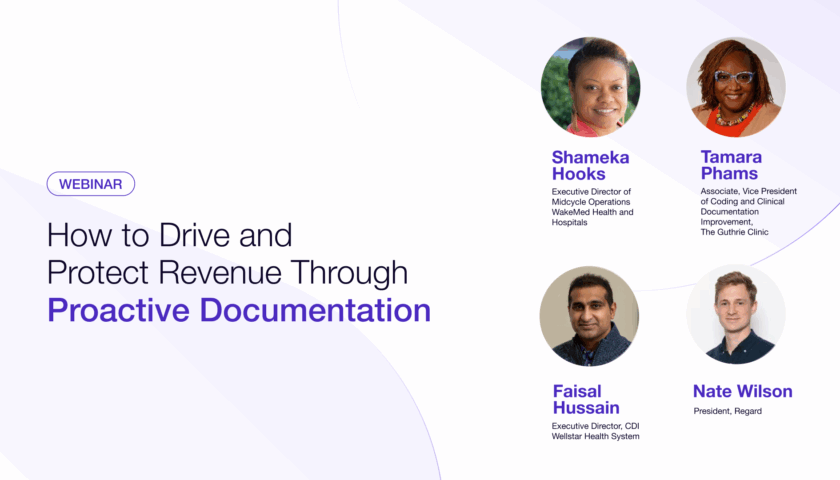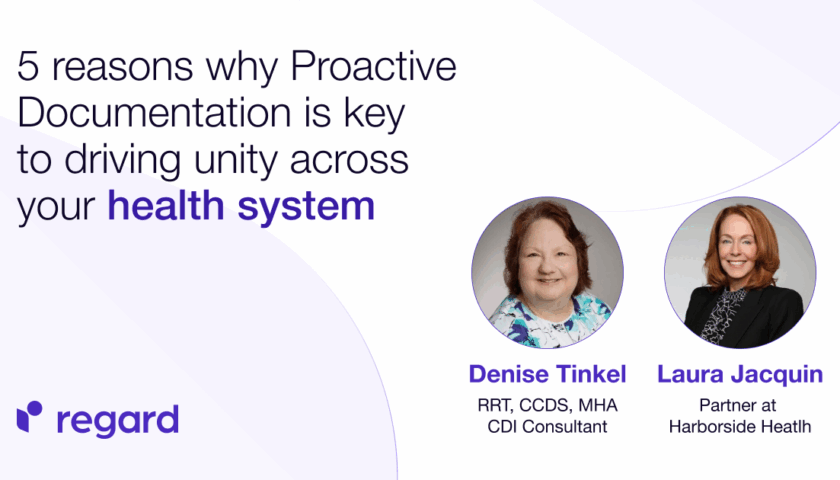
In our April webinar cohosted with Becker’s Hospital Review, Regard president and cofounder Nate Wilson sat down with three other healthcare experts to discuss one of the industry’s most persistent and evolving challenges: documentation.
Director of Clinical Documentation Integrity at Stanford Healthcare, Michelle McCormick provided a nurse’s perspective and brought 20 years of experience in the CDI field. She was joined by internal medicine physician and hospitalist Dr. Patrick Woodard, who is also the CIO at Monument Health. President-elect of the American Health Management Association and former VP of mid-revenue cycle at Cedars Sinai Thea Campbell rounded out the panel of experts.
Their discussion revolved around the need for Proactive Documentation to alleviate the current challenges medical documentation presents for all stakeholders in the healthcare ecosystem. While the issue is complex, it’s clear that AI-driven tools can be a key part of the solution for physicians and CDI teams, while improving communications and rapport between these groups.
Our experts also explained how Proactive Documentation can improve patient outcomes, even saving lives. Providers and hospitals enjoy higher reimbursement rates and increased revenue when they optimize documentation.
Learn more from the panelists and watch the webinar here.
Administrative burden takes a toll
Documentation is critical to patient care and healthcare revenue, but according to Michelle, “It’s a burden on any of the users–from coding to CDI, abstractors, HIM, and the patients.
Some of these medical records are so voluminous, it’s a chore all the way around.”
Dr. Woodward recognized that the volume, complexity, and (often) inaccuracy of patient charts can put patient care at risk, while documentation duties can lead to burnout for providers. He explained, “Unfortunately, that’s the reality of being a physician today. You’re doing the clinical care, but you’re also trying to make sure that you capture everything for the risk adjustment reasons on the back end. Pulling the correct and relevant information from voluminous charts is a big challenge.”
Thea echoed these thoughts, adding, “Doctors don’t go into the practice of medicine to dig through records and remember codes. Their value is in solving problems and putting together a comprehensive patient care plan. In an ideal world, doing that work would result in good documentation that could support the business. But I don’t think we see that now; it’s an incredible struggle, and we’re putting our providers in a very challenging position.”
She explained that moving from paper to electronic records was just the first step to addressing the administrative burden; it still resulted in an overwhelming amount of information that was impossible to contextualize and all too easy to miss important diagnostic details. Without tools and technology to alleviate this burden and elevate insights, Thea said, “We’re defaulting to the patient as the historian of their information.”
“Information is power, but we are drowning in it right now. We have to develop tools to synthesize that information.”
–Thea Campbell, AHIMA
Nate validated the panelist’s perspectives, sharing that Regard regularly reviews entire patient charts and has found that the average record contains about 50,000 data points. “We’re so far beyond the human capacity to keep up with that data,” he said. Yet, physicians are expected to keep up and make informed decisions for their patients. This has led to a burnout epidemic across healthcare professionals.
Proactive versus reactive documentation
The expert panel went on to agree that much of this burden can be lifted with Proactive Documentation. Today, nearly all documentation is reactive. It happens after a doctor sees a patient, when CDI teams send queries to gather information needed to meet a battery of requirements, including CC, MCC, and HCC capture.
Dr. Woodard reported that queries can come in days or weeks after a patient is discharged–well past the time a doctor can remember details about the case. “Being able to move all of that decision making forward has value both for the physician and patient. That’s a person who will benefit from information being available at the time of care rather than retrospectively. It doesn’t really help after the fact.”
Both Thea and Michelle emphasized that Proactive Documentation is not just about when data is entered, but what data is added to the EHR. The right terms, codes, and justifications must be included. Thea described the proactive mindset as the difference between, “documenting what I did versus using information to demonstrate why I drew the conclusion I did.”
For Nate, this brought up the problem of the Clinical Insights Gap. He explained, “We have so much data on every single patient that there’s a huge blind spot that’s never seen by the clinician. If a physician can only review a fraction of that data, they’re going forward with what they saw, not what’s buried in the chart.” He shared that Regard is determined to close this gap by leveraging technology to review 100% of available data and recommend diagnoses with supporting evidence and treatment plans. “It effectively becomes a first draft of the clinician’s note. Imagine having a 90-99% complete note for your patient before you even walk in the room.”
CDI teams and physicians as partners
The demands of documentation drive different priorities for those involved in the process. However, all our experts agreed that a partnership approach across clinicians and CDI teams is a key factor in enhancing patient, physician, and business outcomes. And leveraging technology that serves all stakeholders can facilitate better relationships and results.
According to Michelle, “Where CDI really needs to go as a profession is helping providers and others with the experience of documentation. It’s not just about getting X number of queries, CCs, and MCCs. It’s also considering the experience so we can get that information natively.”
“Patient care is a team sport.”
–Michelle McCormick, Stanford Healthcare
Thea added to the sentiment: “A key point here is operating at the top of your skill set. I don’t need a physician digging through a chart. There’s nothing fun about that for a doctor, administrator, or CDI. Having a tool that can do that for us so we can make decisions and do work at the top of our talents and abilities to bring meaning to what we’re doing is so incredibly key.”
Nate responded by describing how Regard has helped CDI and clinical teams collaborate more effectively and operate more efficiently. “Identifying and recommending a diagnosis means we can actually work with CDI, HIM, even coding and billing teams to set the clinician up for success with a first draft that’s going to save them time. It’s going to improve outcomes. It’s also going to capture the things you really care about as a documentation team.”
To learn more about how Proactive Documentation can transform your health system and what a partnership with Regard can look like, schedule your introductory call with us! We can’t wait to show you how we’ve saved providers valuable time through reducing administrative burden, improved patient outcomes, and driven hospital revenue at healthcare systems just like yours.


